Pholcidae
Daddy-longleg spiders
Dimitar Dimitrov


This tree diagram shows the relationships between several groups of organisms.
The root of the current tree connects the organisms featured in this tree to their containing group and the rest of the Tree of Life. The basal branching point in the tree represents the ancestor of the other groups in the tree. This ancestor diversified over time into several descendent subgroups, which are represented as internal nodes and terminal taxa to the right.

You can click on the root to travel down the Tree of Life all the way to the root of all Life, and you can click on the names of descendent subgroups to travel up the Tree of Life all the way to individual species.
For more information on ToL tree formatting, please see Interpreting the Tree or Classification. To learn more about phylogenetic trees, please visit our Phylogenetic Biology pages.
close boxIntroduction
Probably one of the spider genera best known to humans is the pholcid genus Pholcus. Commonly known as daddy-longlegs or cellar spiders, many species from this genus are synanthropic and often share our houses with us. Daddy-longlegs are even important characters in children's tales such as The Tale of Daddy-longlegs by Scott Arthur Bailey. However in some places "daddy-longlegs" is used when referring to harvestmen (Opiliones).
Pholcids show very high ecological plasticity and can be found everywhere, from deserts to humid tropical forests. Similar to many other arthropod groups the pholcids are most diverse in the tropical regions of the world. Several studies have shown that pholcids might be among the commonest if not the dominating web builders in some tropical regions (Manhart, 1994; Huber, 2000, 2003a). Currently there are 85 genera and 1000 species (Platnick, 2009) of pholcids but recent evidence shows that most of the diversity of this group is still unknown (Huber, 2000, 2003a, 2003b, 2003c, 2005a, 2005b, 2007).
Characteristics
Most pholcids are relatively small spiders with rounded prosoma and legs that usually are disproportionately long in relation to their body size. In some species legs may be over 20 times the body length of the animal. However, many leaf litter species have quite short legs. Pholcids are very variable in body shape and coloration but there are several diagnostic characters that distinguish them from other relatives. The most important are: the modified male palpal paracymbium called procursus, the sexual modifications of the male chelicerae and the pseudosegmentation of the leg tarsi.

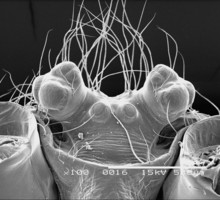
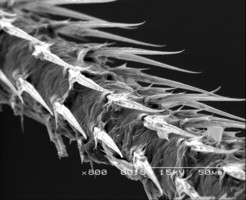
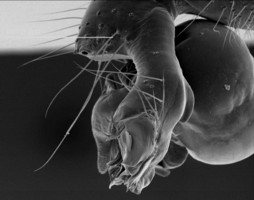
Left: Prosoma of Pholcus edentatus frontal. Note the hornlike elevations on which lateral eye triads are placed. Center: Leg IV tarsus of Pholcus edentatus. Right: Male pedipalp of Pholcus ornatus. Note the conspicuously enlarged and modified paracymbium (procursus). Images © 2005 Dimitar Dimitrov
Pholcids have eight or six eyes. Eyes are arranged in two lateral triads and the anterior median eyes are placed in between, on the frontal part of the prosoma. In six-eyed species the anterior median eyes are absent. In some genera eyes are placed on conspicuous elevations of the prosoma. These often resemble a pair of horns, each one carrying one of the lateral eye triads. In many cave dwelling species eyes are further reduced in number and size and in many troglobite species eyes are completely lost.
The vast majority of pholcids build webs which vary greatly in size and complexity. Many species construct irregular three-dimensional webs but more ordered sheet webs are also no exception.
Reproductive biology in pholcids and functional morphology of their genitalia is fairly well studied (e.g., Gerhardt, 1921, 1923, 1924, 1927, 1929; Uhl et al., 1995; Eberhard and Briceño, 1983, 1985; Huber, 1994, 1995, 1997a, 1997b, 1998, 2002; 2004, 2006; Huber and Eberhard, 1997). Pholcids have a fairly complex courtship behavior and numerous male structures besides the pedipalps, such as modified cheliceral hairs and/or apophysis and in some cases even apophyses on the clypeus, are involved in the copulation.

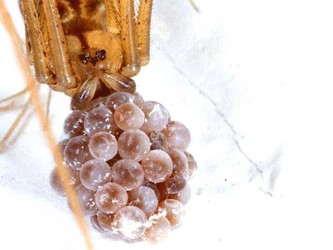
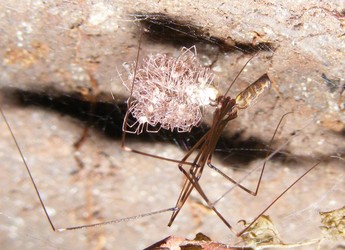
Left: Holocnemus pluchei holding her eggs. © 2005 Cesare Brizio Right: Smeringopina bineti showing maternal care for her spiderlings. © 2008 Berhnard Huber
Pholcids lay few eggs, in some cases less than 10. Females do not make cocoons but carry the eggs in their jaws. Often, maternal care continues for some time after the spiderlings have hatched. Spiderlings have shorter legs in relation to their body size than adults, but after several molts leg-to-body-size proportion changes.
Discussion of Phylogenetic Relationships
Despite important advances in recent years (Huber, 2000; Bruvo-Madaric et al., 2005) the family level phylogeny of pholcids is still a work in progress. Several subfamilies of pholcids have been named but their limits remain elusive. The phylogenetic hypothesis illustrated above is derived from the only family-wide phylogenetic study that includes molecular and morphological data (Bruvo-Madaric et al., 2005).
References
Bruvo-Madaric B., Huber B.A., Steinacher A., Pass G. 2005. Phylogeny of pholcid spiders (Araneae:Pholcidae): combined analysis using morphology and molecules. Molecular Phylogenetics and Evolution 37: 661-673.
Eberhard W.G., Briceño R.D. 1983. Chivalry in pholcid spiders. Behav. Ecol. Sociobiol. 13: 189–195.
Gerhardt U. 1921. Vergleichende Studien über die orphologie des männlichen Tasters und die Biologie der Kopulation der Spinnen. Arch. Naturgesch. 87: 78–247.
Gerhardt U. 1923. Weitere sexualbiologische Untersuchung an Spinnen. Arch. Naturgesch. 89: 1–225.
Gerhardt U. 1924. Weitere Studien über die Biologie der Spinnen. Arch. Naturgesch. 90: 85–192.
Gerhardt U. 1927. Neue biologische Untersuchungen an einheimischen und ausländischen Spinnen. Z. Morph. Ökol. Tiere 8: 96–186.
Gerhardt U. 1929. Zur vergleichenden Sexualbiologie primitiver Spinnen, insbesondere der Tetrapneumonen. Z. Morph. Ökol. Tiere 14: 699–764.
Huber B.A. 1994. Genital morphology, copulatory mechanism and reproductive biology in Psilochorus simoni (Berland, 1911) (Pholcidae; Araneae). Netherlands Journal of Zoology 44(1-2): 85-99.
Huber B.A. 1995. Copulatory mechanism in Holocnemus pluchei and Pholcus opilionoides, with notes on male cheliceral apophyses and stridulatory organs in Pholcidae (Araneae). Acta Zoologica, Stockholm 76(4): 291-300.
Huber B.A. 1997a. Evidence for gustatorial courtship in a haplogyne spider (Hedypsilus culicinus: Pholcidae: Araneae). Netherlands Journal of Zoology 47(1): 95-98.
Huber B.A. 1997b. On American ‘Micromerys’ and Metagonia (Araneae, Pholcidae), with notes on natural history and genital mechanics. Zoologica Scripta 25(4): 341-363.
Huber B.A. 1998. Genital mechanics in some neotropical pholcid spiders (Araneae: Pholcidae), with implications for systematics. Journal of Zoology, London 244: 587-599.
Huber B.A. 2000. New World pholcid spiders (Araneae: Pholcidae): a revision at generic level. Bull. Amer. Mus. Nat. Hist. 254: 1–348.
Huber B.A. 2002. Functional morphology of the genitalia in the spider Spermophora senoculata (Pholcidae, Araneae). Zoologischer Anzeiger 241(2):105-116.
Huber B.A. 2003a. High species diversity in one of the dominant groups of spiders in East African montane forests (Araneae: Pholcidae: Buitinga n. gen., Spermophora Hentz). Zool. J. Linn. Soc. 137: 555–619.
Huber B.A. 2003b. Cladistic analysis of Malagasy pholcid spiders reveals generic level endemism: revision of Zatavua n. gen. and Paramicromerys Millot (Pholcidae, Araneae). Zool. J. Linn. Soc. 137: 261–318.
Huber B.A. 2003c. Southern African pholcid spiders: Revision and cladistic analysis of Quamtana gen. nov. and Spermophora Hentz (Araneae: Pholcidae), with notes on male-female covariation. Zool. J. Linn. Soc. 139: 477–527.
Huber B.A. 2004. Evolutionary transformation from muscular to hydraulic movements in spider (Arachnida, Araneae) genitalia: a study based on histological serial sections. Journal of Morphology 261: 364-376.
Huber B.A. 2005a. The pholcid spiders of Africa (Araneae: Pholcidae): state of knowledge and directions for future research. In: Huber B.A., Sinclair B.J., Lampe K.-H. (eds.) African Biodiversity: Molecules, Organisms, Ecosystems, pp. 181-186. Springer Verlag.
Huber B.A. 2005b. High species diversity, male-female coevolution, and metaphyly in Southeast Asian pholcid spiders: the case of Belisana Thorell 1898 (Araneae, Pholcidae). Zoologica 155: 1-126.
Huber B.A. 2006. Cryptic female exaggeration: the asymmetric female internal genitalia of Kaliana yuruani (Araneae: Pholcidae). Journal of Morphology 276: 705-712.
Huber B.A. 2007. Two new genera of small, six-eyed pholcid spiders from West Africa, and first record of Spermophorides for mainland Africa (Araneae: Pholcidae). Zootaxa 1635: 23-43.
Huber B.A., Eberhard W.G. 1997. Courtship, copulation, and genital mechanics in Physocyclus globosus (Araneae, Pholcidae). Can. J. Zool. 74: 905–918.
Manhart, C. 1994. Spiders on bark in a tropical rainforest (Panguana, Peru). Stud. Neotrop. Fauna Environ. 29(1): 49–53.
Platnick N.I. 2009. The world spider catalog, version 9.5. American Museum of Natural History, online at http://research.amnh.org/entomology/spiders/catalog/index.html
Uhl G., Huber B.A., Rose W. 1995. Male pedipalp morphology and copulatory mechanism in Pholcus phalangioides (Fuesslin, 1775) (Araneae, Pholcidae). Bull. Br. Arachnol. Soc. 10(1): 1–9.
Information on the Internet
- Pholcidae: the longest legs on the web. Very extensive and up to date resource about pholcids, maintained by Bernhard Huber.
Title Illustrations

| Scientific Name | Pholcus opilionoides |
|---|---|
| Location | Austria |
| Specimen Condition | Live Specimen |
| Identified By | Bernhard Huber |
| Sex | Male |
| Life Cycle Stage | Adult |
| Copyright |
© 2007 Bernhard A. Huber

|
| Scientific Name | Mesabolivar cyaneotaeniatus |
|---|---|
| Location | Brazil |
| Specimen Condition | Live Specimen |
| Identified By | Bernhard Huber |
| Copyright |
© 2007 Bernhard A. Huber

|
About This Page
Dimitar Dimitrov

Zoological Museum, University of Copenhagen
Correspondence regarding this page should be directed to Dimitar Dimitrov at
dimitard.gwu@gmail.com
Page copyright © 2009 Dimitar Dimitrov
 Page: Tree of Life
Pholcidae. Daddy-longleg spiders.
Authored by
Dimitar Dimitrov.
The TEXT of this page is licensed under the
Creative Commons Attribution-NonCommercial License - Version 3.0. Note that images and other media
featured on this page are each governed by their own license, and they may or may not be available
for reuse. Click on an image or a media link to access the media data window, which provides the
relevant licensing information. For the general terms and conditions of ToL material reuse and
redistribution, please see the Tree of Life Copyright
Policies.
Page: Tree of Life
Pholcidae. Daddy-longleg spiders.
Authored by
Dimitar Dimitrov.
The TEXT of this page is licensed under the
Creative Commons Attribution-NonCommercial License - Version 3.0. Note that images and other media
featured on this page are each governed by their own license, and they may or may not be available
for reuse. Click on an image or a media link to access the media data window, which provides the
relevant licensing information. For the general terms and conditions of ToL material reuse and
redistribution, please see the Tree of Life Copyright
Policies.
- First online 12 February 2009
- Content changed 12 February 2009
Citing this page:
Dimitrov, Dimitar. 2009. Pholcidae. Daddy-longleg spiders. Version 12 February 2009 (under construction). http://tolweb.org/Pholcidae/2719/2009.02.12 in The Tree of Life Web Project, http://tolweb.org/




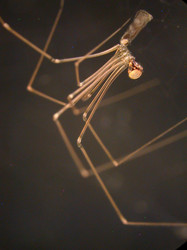
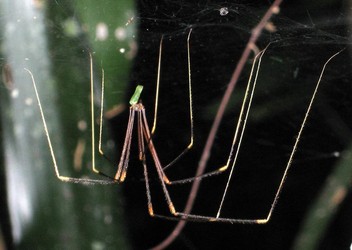



 Go to quick links
Go to quick search
Go to navigation for this section of the ToL site
Go to detailed links for the ToL site
Go to quick links
Go to quick search
Go to navigation for this section of the ToL site
Go to detailed links for the ToL site